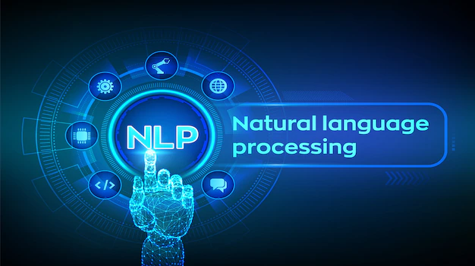NLP stands for Natural Language Processing, which is a field of Artificial Intelligence (AI) and Computer Science that focuses on the interaction between computers and human (natural) languages. The goal of NLP is to develop algorithms, models, and systems that can understand, interpret, and generate human language in a way that is both accurate and efficient. NLP is used in a variety of applications, such as language translation, text summarization, sentiment analysis, and more.
NLP is a multidisciplinary field that combines knowledge and techniques from linguistics, computer science, mathematics, and artificial intelligence. It involves the study of many different aspects of language, including syntax, semantics, and pragmatics, as well as the use of statistical and machine-learning techniques to analyze and process text data.
Some common tasks in NLP include:
- Language understanding: converting spoken or written language into structured data that a computer can process.
- Language generation: creating written or spoken language, such as text summarization, question answering, and text-to-speech synthesis.
- Sentiment analysis: determining the sentiment or emotion conveyed in a piece of text, such as whether it is positive, negative, or neutral.
- Named entity recognition: identifying and extracting specific pieces of information, such as names of people, places, and organizations, from the text.
- Part-of-speech tagging: identifying the grammatical role of each word in a sentence, such as a noun, verb, adjective, etc.
NLP is used in many applications such as chatbots, virtual assistants, language translation, automated text summarization, sentiment analysis, social media monitoring, and more. It also plays an important role in fields such as information retrieval, natural language generation, and machine translation.
Question Answering
Question answering (QA) is a task in natural language processing (NLP) that involves developing algorithms and systems that can understand and answer questions posed in natural language. The goal of QA systems is to provide accurate, relevant, and complete answers to questions in a way that is both efficient and easy for users to understand.
There are several different types of QA systems, including:
- Retrieval-based QA: These systems rely on a pre-existing database of information and use algorithms to search for and retrieve the most relevant answers to a given question.
- Generation-based QA: These systems use natural language generation techniques to create new answers based on the information in their database.
- Hybrid QA: These systems use a combination of retrieval-based and generation-based methods to provide the most accurate and complete answers possible.
QA systems can be used in a variety of applications, such as chatbots, virtual assistants, knowledge bases, and more. It is commonly used in information retrieval, knowledge management, customer service, education and more.
The QA system relies on the ability of the NLP models to understand the natural language and to process the natural language text to extract meaningful information. With the help of machine learning models, QA systems can also learn to answer more complex questions over time and improve their performance.
Natural Language Generation
Natural Language Generation (NLG) is a subfield of natural language processing (NLP) that focuses on the automatic creation of natural language text. The goal of NLG is to enable computers to produce human-like text that is both natural-sounding and informative. NLG systems can be used to generate a wide range of text types, including reports, summaries, narratives, and responses.
There are several different approaches to NLG, including:
- Template-based generation: This approach uses predefined templates to generate text. The system fills in the templates with data to produce the final output.
- Statistical NLG: This approach uses statistical models to learn the relationship between the input data and the output text. The models are trained on a dataset of input-output pairs and then used to generate new text.
- Neural NLG: This approach uses neural networks, specifically Transformer-based architectures, to generate text. These models are trained on large datasets of text and can generate human-like text.
NLG is used in a variety of applications, such as chatbots, virtual assistants, automated report generation, and more. It can be used to generate customer service responses, sports reports, weather forecasts, news summaries, and much more. NLG can also be used to help people understand complex data by generating natural language explanations of the data.
It is important to note that NLG is still a challenging task, as it requires a deep understanding of natural language and the ability to control the style and tone of the generated text. The use of pre-trained models and fine-tuning them for specific datasets can improve the performance of NLG. Additionally, the use of human evaluation and user testing to evaluate the quality of the generated text is also important to ensure that the text is natural-sounding and informative.
Machine Translation
Machine translation (MT) is the task of automatically translating text from one natural language to another using computational methods. The goal of machine translation is to produce translations that are as accurate and natural-sounding as those produced by human translators.
There are several different approaches to machine translation, including:
- Rule-based machine translation: This approach relies on a set of hand-crafted rules to translate text from one language to another.
- Statistical machine translation (SMT): This approach uses statistical models to learn the relationship between the source and target languages from a parallel corpus of texts.
- Neural machine translation (NMT): This approach uses neural networks to model the relationship between the source and target languages. NMT has been shown to produce more accurate translations than traditional SMT.
Machine Translation is widely used in several applications such as language education, business, and international communication. It can be used to help people in different countries communicate with one another, to provide access to information in other languages, and to help people learn new languages. NMT specifically has been used in several applications such as chatbots, virtual assistants, language learning, e-commerce, and customer service.
It is important to note that, Machine Translation is still an open research area and there are many challenges that need to be addressed such as idiomatic expressions, cultural references, and the meaning of words in context. The use of pre-trained models, fine-tuning and use of additional resources such as bilingual dictionaries and parallel corpora can improve the performance of Machine Translation.
Sentiment Analysis
Sentiment analysis, also known as opinion mining, is a task in natural language processing (NLP) that involves using algorithms and models to determine the sentiment or emotion expressed in a piece of text. The goal of sentiment analysis is to classify the text as having a positive, negative, or neutral sentiment, or to extract more fine-grained information such as the intensity or subjectivity of the sentiment.
There are several different approaches to sentiment analysis, including:
- Rule-based approaches: These methods rely on a set of hand-crafted rules to classify text into different sentiment categories.
- Statistical approaches: These methods use machine learning techniques to train models on a dataset of labelled text and then apply the models to classify new text.
- Hybrid approaches: These methods combine rule-based and statistical approaches to improve the performance of sentiment analysis.
Sentiment analysis is used in a variety of applications, such as marketing research, customer service, and social media monitoring. It can be used to track public opinion on a product or brand or to monitor social media for mentions of a company or topic. Sentiment analysis can also be used to identify patterns and trends in large amounts of text data, such as customer reviews or social media posts. It can also be used to help in decision-making, for example, in stock market predictions and politics by monitoring public opinion.
It is important to note that sentiment analysis is a challenging task as it is hard to infer the sentiment in the text as it is often context-dependent and the use of sarcasm, irony and other forms of figurative language can make the task more difficult. Using pre-trained models and fine-tuning them for specific datasets can improve the performance of sentiment analysis.



